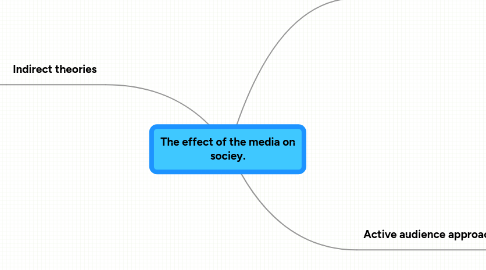
1. Indirect theories
1.1. Two step flow.
1.1.1. The opinion leader has the power to influence people views on certain issues as they are seen as a specialist in that field, such as war and sports journalists.
1.1.1.1. Neo Marxism relates to this as it is not only the owners who have control but also the media professionals such as journalists and editors.
1.2. Cultural effects theory
1.2.1. Media has a different effect on people depending on their class, age, gender and ethnicity. People like Murdoch will own various outlets that effect different cultures.
1.2.1.1. This in a way relates to the GUMG's research which said audiences are active as they are influenced differently due to their values. So relates to Neo-Marxists research.
1.3. Drip-Drip
1.3.1. Gaunlett (2008)
1.3.1.1. Suggests that constant exposure to certain media messages over a period of time will mean the audience will buy into the product. Such as the message that iraq had weapons of mass destruction before the war, was repeated so many times it became believable.
2. Hypodermic Syringe Model
2.1. Packard
2.1.1. the audience are all the same. The media owner has the ability to directly inject messages into the audience. They can determine what is common sense. Examples of this is he water shed and age restrictions which limit what people see.
2.1.1.1. This relates the marxism as Packard believes the media owners have the power and ability to almost control the audience as they are choosing what they allowed to view and what they are not.
2.2. Bandura
2.2.1. Bobo Doll (1963) Children who are exposed to violence, will act violently. Young children got shown a video of a child acting violently towards a doll and did the same.
2.3. Feshbach & Singer
2.3.1. (1971) exposed one group to media violence and one to not. They found that the ones exposed acted less violent, media seen as a release.
2.4. Gaunlett
2.4.1. (1995) Criticises theories that say media directly causes issues such as crime as they ignore other social issues such as social inequalities.
3. Active audience approaches.
3.1. Uses and Gratification model Blumler & McQuail
3.1.1. Individuals are active in their approach to the media and use it in a number of ways such as an escape, and a way of gathering information
3.1.1.1. Relates to pluralism as the audience use the media to benefit their needs, they choose how to use the media and what for.
3.2. Selective filter model
3.2.1. Klapper
3.2.1.1. We are influenced by what we like and are interested in. For example if we are interested in a certain issue and there is a programme based on it, we will watch it.
3.2.1.1.1. Relates to pluralism as the audience are choosing what they want too watch. If they are not interested in a certain programme, they will not watch it.
3.3. Structured Interpretation Model
3.3.1. Morley
3.3.1.1. Reaction are based on your C.A.G.E. A pensioner would be more likely to have a dominant reading, which would be the obvious opinion on issues such as youth. Whilst youth would have a more oppositional view, on things like drug use.
3.3.1.1.1. New node
